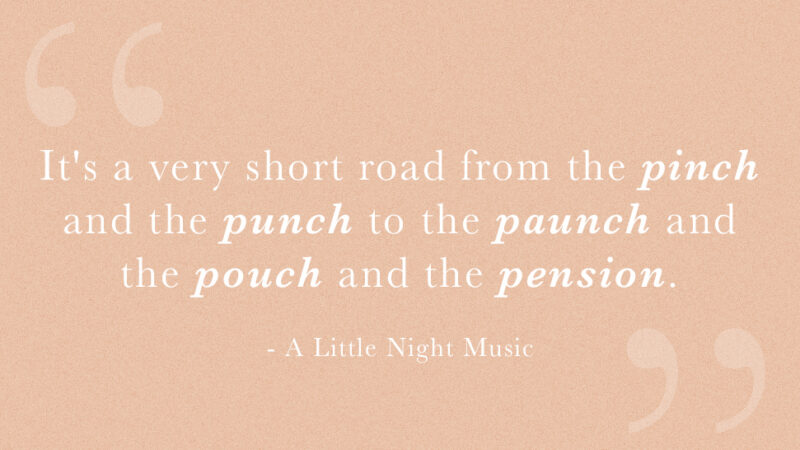Stephen Sondheim, the composer-lyricist whose thematically complex, lyrically nimble, and musically challenging scores changed the face of musical theatre during the latter half of the 20th century, and continue to influence the genre and its artists today, died November 26. He was 91. The news was confirmed to the New York Times by Mr. Sondheim's lawyer and friend, F. Richard Pappas.
A 1994 cover story in the New York Times Magazine asked “Is Sondheim God?” and, indeed, by that point in his career—the year his last major work, Passion, debuted on Broadway—he had attained the status of a deity in the theatre. He retained that towering position for the remainder of his long life, inspiring a sort of adulation, artistic analysis, and ever-increasing reputation enjoyed by no other composer in his field. “Mr. Sondheim bears a relationship to his vocation that is unlike that of any artist in any other field,” noted New York Times critic Ben Brantley in his review of the 2010 Broadway show Sondheim on Sondheim, one of many celebratory revues the writer enjoyed through his career. “Even when his shows have been commercial flops, they are studied, revered, and eventually reincarnated to critical hosannas.”

That career began as auspiciously as possible, as a junior partner in the team of Arthur Laurents, Leonard Bernstein, and Jerome Robbins, who brought West Side Story to life. The musical, a New York gangland take on Romeo and Juliet, was groundbreaking—as would be many shows in the man’s long career. Though he chafed at functioning only as a lyricist—he had written full songs from the time he was a teenager, as the adoring protege of lyricist Oscar Hammerstein II—he contributed to another instant classic, Gypsy, before finally striking out on his own with the 1962 knockabout farce A Funny Thing Happened on the Way to the Forum. Though the Zero Mostel comedy was full of slapstick and broad humor, Mr. Sondheim’s songs stood out even then for their worldly-wise wit and wordplay.
Short runs for Anyone Can Whistle and Do I Hear the Waltz? followed. But then came 1970, when, with Company, his star rose and never dimmed. The world was in tumult; America had shed its confident post-War persona, torn asunder by war, civil rights battles, sexual revolution, and general dissolution. The moment was ripe for the string of neurotic, rueful, musical self-examinations that Mr. Sondheim brought to life with director Harold Prince, in one of the most famous and fruitful collaborations in theatre history. Company, a dissection of married life, and Follies, about the impossibility of reliving the past, smashed illusions left and right—about the nature of American life, as well as what an American musical should look and sound like. A new production, re-imagined by director Marianne Elliott to center around a female protagonist, is currently in previews on Broadway, a transfer from London's West End. Prior to a pandemic delay, the production was scheduled to open on Mr. Sondheim's 90th birthday in 2020.
Follies, which takes place at a reunion of aging veterans of Ziegfeld Follies-like performers, was, according to young critic Frank Rich, nothing less than “the death of the American musical as a metaphor for the death of American innocence.” It was “the first Proustian musical,” Time magazine said.
To the composer’s eye, any subject matter was a suitable subject for musicalization. Ingmar Bergman’s film Smiles of a Summer Night, about a series of civilized trysts among the Swedish upper classes, became A Little Night Music in 1973. Admiral Perry’s opening of Japan to Western trade and influence became Pacific Overtures in 1976. Mr. Sondheim and bookwriter Hugh Wheeler turned a penny dreadful about a vengeful, murderous Victorian London barber into the operatic Sweeney Todd in 1979.

Mr. Sondheim reached a sort of apogee of achievement and adulation in 1984 with Sunday in the Park With George, his look at the post-Impressionist French painter George Seurat’s creation of his masterpiece A Sunday Afternoon on the Island of La Grande Jatte, and, more generally, the very nature of artists and art-creation. The New York Times’ Frank Rich made a personal mission out of championing the show, which had an intricate, Pointillistic score to match Seurat’s style of painting. Mr. Sondheim won the Pulitzer Prize for Drama, if not the Tony Award. (Previous Sondheim shows to win Best Musical Tony Awards included A Funny Thing Happened..., Company, A Little Night Music, and Sweeney Todd. He would win again for Passion in 1994, and take home a Lifetime Achievement Tony in 2008.)
From Sunday on, he could do little wrong in the eyes of critics. Early gripes against his work—that it lacked memorable melodies; was mordant and too cynically sophisticated for its own good; that it espoused an essentially dark view of human nature—faded, and his every artistic move was anticipated and closely watched, even as his new works became rarer.
Stephen Joshua Sondheim was born March 22, 1930, in Manhattan, New York City, a city whose mores and culture he would write about so tellingly in Saturday Night, Company, Follies, and Merrily We Roll Along. His father, Herbert Sondheim, was a dress manufacturer with a musical ear. His mother, whose maiden name was Janet Fox, and was called “Foxy” by everyone, was a vivacious, would-be sophisticate who was her husband’s chief designer. The family moved into the newly built and fashionable Sam Remo towers on Central Park West. Herbert Sondheim was a self-taught piano player who would pick out Broadway tunes on the piano, and would put his son’s hand on his little finger as he played the melody. Young Stephen took piano lessons for two years beginning when he was seven years old. He began another two years when he was 14.
Life changed irrevocably when he was ten. His father left his wife for another woman, and Mr. Sondheim was sent to military school. Mr. Sondheim’s relationship with the willful, charismatic Foxy following the divorce was tempestuous. In the biography Sondheim: A Life, he would claim that, when he was a teenager, she would try to sexually provoke him. Jamie Hammerstein characterized their relationship as something out of Who’s Afraid of Virginia Woolf?.
As a young man, he found solace with the Hammersteins, who lived just a few miles from Doylestown, Pennsylvania, where his mother had bought a home. Oscar Hammerstein II became a second father and musical mentor to him. The elder man taught him the importance of choosing each word with meticulous care. Once, when Stephen was 15, the young man gave Hammerstein his first complete show, called By George, asking for his honest, objective opinion. Hammerstein stunned the boy by doing just that, telling him it was the worst thing he’d ever read. He then, however, spent the afternoon going over the script with him, line by line, telling him why it was terrible. “If it hadn’t been for the Hammersteins, I really don’t know where I would be—if I’d even be alive,” said Mr. Sondheim. “That’s essentially how I became a songwriter. Because I wanted to do what Oscar did. I’ve often said that if he had been a geologist, I would probably have been a geologist.”
Mr. Sondheim went to the prep school George School in Pennsylvania, then attended Williams College in Massachusetts, where he found an inspiring music teacher in Robert Barrow. He won the Hutchinson Prize upon graduating from Williams, which won him the opportunity to take lessons with noted avant-garde composer Milton Babbitt. Babbitt, who was disdainful of show business, noted that the young writer wasn’t very interested in becoming a “serious composer,” but “wanted to know a great deal more about serious music because he thought it would be suggestive and useful.”
He based his first professional show, Saturday Night, which he wrote when he was 23 years old, on a play called Front Porch in Flatbush by Philip and Julius Epstein, well-known screenwriters. But after six backers' auditions, leading producer Lem Ayers suddently died, and the project died on the vine. Opportunity came knocking when he met playwright Arthur Laurents at a party at the home of actor and salon hostess Ruth Ford. In one of the most legendary moments of serendipity in musical history, Laurents mentioned he was working on a musical with Jerome Robbins and Leonard Bernstein and they were looking for a lyricist. Mr. Sondheim was initially not much interested in just writing lyrics for West Side Story—at that time, his lyrics were more highly rated than his music, a state of opinion that would persist for many years to come—but Oscar Hammerstein said, “Take the job.” And he did. “A true luck story,” Mr. Sondheim later called it. His career in the theatre began.
Neither Anyone Can Whistle, nor Do I Hear a Waltz? helped his reputation as a composer-lyricist much at the time of their premieres. Both were short-lived on Broadway. He later confessed to regretting writing the latter, which was a collaboration with Richard Rodgers and based on friend Arthur Laurents’ play The Time of the Cuckoo. “When Hammerstein was dying, he asked me if I would consider doing a show with Dick Rodgers. He said, ‘I know you want to do your own music. But Dick is going to feel very bereft and if he has any ideas and throws them to you I wish you would give them some consideration.’ So when Arthur Laurents suggested that he and I do his play, The Time of the Cuckoo as a musical with Richard Rodgers, I thought this was one way of killing two birds with one stone.”

Mr. Sondheim recalled meeting Harold Prince in the early 1950s through mutual friend Mary Rodgers, though Prince put the meeting much earlier, at the opening night of South Pacific. Prince would produce the early Sondheim shows West Side Story and Forum, but with Company he would graduate to producer-director. Company grew out of a series of one-act plays written by George Furth, an actor-playwright friend of the composer. Sondheim liked them and asked Prince what he thought of the vignettes, which were mostly about marriage and relationships. Prince suggested they would make a good musical about the state of marriage today.
The three men began working on the project, Furth retaining only a portion of the original one-acts, and Boris Aronson creating a famous, non-site-specific, multi-tiered set. To understand his subject matter better, Sondheim—who admitted to knowing little about committed relationships—asked friend Mary Rodgers, who was on her second marriage, to come over and discuss her experiences. “I took a yellow pad out and I took notes, exactly as if it were a lecture.”
Company not only impressed critics, it confounded and startled them. It would become the first of what would later be termed “concept musicals,” shows that hung loosely on a narrative storyline as opposed to a plot, and trafficked more in ideas than emotions. “Until Company, I thought that musicals had to have very strong plots,” said Mr. Sondheim. “One of the things that fascinated me about the challenge of the show was to see if a musical could be done without one.” The script centered on the never-married Bobby and his ten best friends, all married, who act as a sort of Greek chorus, commenting on the hero’s actions. Aside from the New York Times—whose Clive Barnes would often fault Sondheim shows for a surfeit of cynicism and a paucity of heart—the critics hailed it as brilliant. “So extraordinary in execution that it defies comparison with any musical that has come before it,” wrote one.
Prince had agreed to produce Mr. Sondheim’s next musical even before he set upon directing Company. Initially called The Girls Upstairs, it grew into Follies, a work even more ambitiously conceptual than Company. Librettist James Goldman originally envisioned the piece as a sort of murder mystery. But Prince was inspired to change the focus of Follies by a photograph of Gloria Swanson standing in the rubble of the Roxy Theatre. The story was set at a reunion of veterans of a pre-WWII follies, among them two former showgirls who had met their husbands as stage door Johnnies. An impromptu revue ensues, with faded stars performing their signature tunes of yesterday—all brilliant musical pastiches of bygone theatre styles. This yielded to an opulent fantasy sequence in “Loveland,” in which the four spouses perform songs illustrating their own personal follies.
Critics praised it as possessing “a rare complexity of structure and feeling.” As with Company, it won the Tony Award for Best Score.
Mr. Sondheim would win a third consecutive Tony for Best Score for his next work, A Little Night Music. The show marked another thematic departure, a near-operetta taking place in turn-of-the-century Sweden, and composed entirely in three-quarter waltz time. The show became a rarity: a money-making Sondheim musical. It also produced the writer’s single popular hit song, “Send in the Clowns,” which was recorded by Judy Collins and became a top-40 hit.
Mr. Sondheim’s musical influences were various and many. The spare, ornamental score of Pacific Overtures was built around a quasi-Japanese pentatonic scale. And his sweeping score for Sweeney Todd was partially inspired by Hollywood composer Bernard Herrmann, whose score for the 1940s film noir Hangover Square he had admired since first seeing the movie as a teenager.

Sondheim and Prince’s professional relationship ended with Merrily We Roll Along in 1981. A musical version of the Kaufman and Hart play about the price friendship and integrity pay in the pursuit of success, the story ran backwards, from the present to the past, tracing the roots of the central three characters. The score went on to be praised as one of Sondheim’s most memorable and tuneful; Prince later admitted he could not find the right vision or look for the piece, which he had decided to cast using sweatshirt-donning theatre students who were in their teens. The musical’s problems were slavishly recounted in the press, and the reviews bad. “Compromise, the sellout, loss of integrity,” wrote Walter Kerr. “These are not so much fighting words to Prince and Sondheim as they are creative words, words that help them choose their materials.” The resultant flop led to a breakup between the two collaborators. Prince felt they had “run out of steam.”
Producer Lewis Allen introduced Sondheim to the man who would become his next, and second most important, collaborator in his life, a 30-something playwright named James Lapine, who at that point only knew Sondheim from Sweeney Todd. They met to discuss a possible musical based on Nathanael West’s satire A Cool Million, and ended up hatching the idea of a show about Georges Seurat. Critics and colleagues would come to see parallels between the composer and his dual subjects—the cloistered, intense, socially-detached Seurat, whose life is consumed in “Finishing the Hat,” and his great-grandson, another artist, who is the focus of the second act. But Mr. Sondheim would insist the musical was primarily the child of Lapine.
Like Sunday, Mr. Sondheim and Lapine’s next show, Into the Woods, was divided into two distinct acts, the first illustrating The Shining Ideal and second revealing The Cruel Reality. A host of classic fairy-tale characters (Cinderella, Little Red Riding Hood, Jack of beanstalk fame) get what they want by first act curtain. But in a second, bittersweet act, those achievements have unexpected, real-world complications. The show also contained pointed examinations of the nature of parenting (“Children Will Listen”) and the fallibility of mothers and fathers.
Sondheim and Lapine’s third major collaboration, Passion, derived from Sondheim seeing Passione d’amore, a 1981 Italian film by Ettore Scola about the bottomless, selfless love of an ugly woman named Fosca for Giorgio, an attractive soldier. Besides Sweeney Todd, it was the only idea for a Sondheim musical that had come from Sondheim himself. “We’re all Fosca,” he argued. “I think we’re all also Giorgio.” Critical reception was divided between those who found the show dark and depressing and those who thought it adult and inspired. But, as with nearly all Sondheim shows, Passion’s reputation only grew with time.
Assassins came next, in 1991. In it, he and librettist John Weidman stepped through the looking glass to survey American history through the eyes of Presidential assassins. Its Off-Broadway opening unhappily coincided with the first Gulf War, canceling its hopes of moving to Broadway. Assassins would not reach a Broadway theatre until a heralded 2004 revival directed by Joe Mantello. A new revival production from director John Doyle opened at Off-Broadway's Classic Stage Company November 14.
Fifteen years would pass between Passion and the New York bow of the 50-years-in-the-making Road Show, a musical telling of the misadventures of the early-20th-century con-men brothers, Addison and Wilson Mizner. By then, major West End, Broadway, and regional revivals of Sondheim musicals were frequent. Many of them were valiant attempts to reclaim and reexamine works that hadn't succeeded the first time around, like Merrily We Roll Along, or to build up one-off curiosities, like The Frogs, which was first performed in a swimming pool at Yale, and Saturday Night, the 1950s work which Mr. Sondheim had once hoped would be his Broadway debut. At the time of his death, he had been at work with playwright David Ives on a musical adaptation of two Luis Buñuel films: The Discreet Charm of the Bourgeoisie (1972) and The Exterminating Angel (1962). Though he had shared in April that progress on the project had stalled, an iteration of the work, under the title Square One, received a developmental reading in September.
Along the way, Mr. Sondheim indulged in a few quixotic projects. Evening Primrose was a 1966 made-for-TV musical about a secret society of people living in department stores. He co-wrote a film with actor Anthony Perkins in 1973, the murder mystery The Last of Sheila. In 1974, he executed a rare acting turn, playing a cynical pianist in a television movie of George S. Kaufman and Ring Lardner’s comedy June Moon. He wrote a few songs for Warren Beatty’s 1990 film Dick Tracy; “Sooner or Later” won him an Oscar. And in 1995, he collaborated with George Furth on his only straight play with Getting Away With Murder.
Throughout his career, Sondheim the man became as much a source of fascination as Sondheim the artist. So vastly skilled, he seemed unknowable, and many found him intimidating. Arthur Laurents remarked that his abundant intelligence caused him to not “suffer fools gladly,” and frequent collaborator Burt Shevelove said he has “a thin veneer of protective varnish that does make people afraid of him.”
His collection of puzzles seemed a fitting metaphor for the complexity of his personality and talent. The walls of his famous Turtle Bay townhouse were covered with 19th-century game boards, and he even created his own homemade puzzles and games. His collection of amusements inspired playwright Anthony Shaffer to write Sleuth after having spent several nights playing games at Mr. Sondheim’s home.
Sondheim himself made self-deprecating fun of his own work habits, regularly calling himself a procrastinator and lazy. “I usually write lying down,” he said, “so I can go to sleep easily.” But, when pressed, he would expound at length about the nature of songwriting and musical theatre. He referred to lyric writing as a craft, while music was to him “the richest form of art.” At the same time, he was always ready to praise the lesser-sung librettists of his musicals as equal artistic partners. “Although one can’t underestimate the importance of the songs, it’s the book that the musical theatre is all about, not the songs, and I’m not being modest. It annoyed me deeply when the reviews of Follies said the show was good in spite of the book. The show is good because of the book.”
By the dawn of the 21st century, the artistic world that Mr. Sondheim created through his shows came to dominate the musical theatre. Young composers were either seen of as following his example (among them Jason Robert Brown, William Finn, and Michael John LaChiusa) or rebelling against it. Actors such as Bernadette Peters, Mandy Patinkin, Len Cariou, Michael Cerveris, Elaine Stritch, Patti LuPone, and Barbara Cook saw their career guided and changed by their exposure to his music. And theatre observers came to generally, and somewhat mournfully, acknowledge that in him, the theatre had seen its last giant.
Toward the end of his life, Mr. Sondheim became more comfortable talking about himself and his status as an icon. He willingly participated in the 2010 revue Sondheim on Sondheim, contributing taped segments of himself talking about his life and his art. In one such segment, discussing Sunday in the Park With George, he observed, “Part of that subject matter is that wonderful thing that happens to any artist when they’re creating art, which is losing the world. You trance out and then you come back into the real world, and it’s both a good and a bad feeling.”
Mr. Sondheim is survived by his husband, Jeffrey Romley; the two were wed in 2017.





























